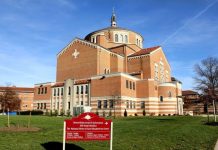Damage inflicted to church properties throughout the Maritimes by post-tropical storm Fiona has yet to be tabulated. Still, it seems, for the most part, Catholic Church property has escaped relatively unscathed after one of the strongest weather systems ever to hit Atlantic Canada.
Newsroom (28/09/2022 10:23 AM Gaudium Press) —Many dioceses across Canada’s east coast — Newfoundland and Labrador, Nova Scotia, Prince Edward Island and New Brunswick — were still without power by midday Sept. 27 in the aftermath due to the high winds and seas that wreaked havoc on the Maritimes, destroying houses and killing at least two people.
Churches of the Archdiocese of St. John’s in eastern Newfoundland and the diocese of Cornerbrook and Labrador in western Newfoundland avoided Fiona’s fury, according to diocesan officials. No response can be obtained from the Diocese of Grand Falls.
Unlike the town of Port aux Basques on the island’s southwest coast, where television images have shown the destruction brought by the high winds and seas. That was the scene of perhaps the most significant devastation, with numerous coastal properties swept into the Atlantic Ocean as storm surge saw giant waves crash onto land in Port aux Basques, where a 73-year-old woman was swept out to sea along with her house.
Fr. Ciro Perez, the pastor of St. Teresa’s Mundy Parish in St. John’s, has been watching images of the calamity in Port aux Basques via the news and online. “We are very fortunate, 950 kilometres away, to avoid the devastation experienced in Port aux Basques,” said Perez. “Our prayers are with them. We have parishioners who have family and friends in the area, and they are working hard to get in contact to receive more information. Absolutely there will be prayers for the victims at Masses this upcoming weekend.”
Communication has been an issue, with Fiona’s high winds and heavy rain knocking out power to much of the Maritimes. At the peak of the post-tropical storm, over 500,000 Maritimers were in the dark. According to the website poweroutage.com, there were still 139,241 households in Nova Scotia, 71,950 in P.E.I. and 3,683 in New Brunswick without power on the morning of Sept. 27.
The Archdiocese of Halifax-Yarmouth had yet to receive any reports of major issues after the storm hit on Sept. 24.
“The debris in front of churches was cleared, and our parishes celebrated Sunday Masses without power in the building,” said Aurea Sadi, Halifax-Yarmouth’s pastoral life and new evangelization coordinator. “The Diocese of Antigonish received the brunt of Hurricane Fiona in Nova Scotia.”
That said, the diocese reported minor damage even as power outages and unsafe roads covered the area in the days following the storm, shuttering schools, hospitals, businesses and governmental buildings.
Calls to the Diocese of Charlottetown in P.E.I. went unanswered. However, Fr. Frank Jay, pastor of St. Mary’s-Holy Family Parish in Kensington, did respond to a Facebook message. He wrote that the storm “stripped off the vinyl siding on the east side” of the church, “sending it all over the centre of town.” Also, “the plastic shield outside on the large Holy Family stained glass window broke, but so did the plastic shields of the United Church beside us.” The sign in front of the church splintered into two pieces and flew across the street onto a neighbour’s lawn. And an “attic window glass in the rectory flew out and spread glass 100 metres down the street.”
While the damage to his parish is unfortunate, Jay shared thoughts about the most pressing problems facing P.E.I. post-Fiona.
“The serious problem on P.E.I. right now is the loss of so many dairy cows, destruction of barns and wharves, devastation of the orchards, flooding of the potato land and flattening of the grain. Our farmers and fishers are going to take the brunt of the suffering. All of the church building losses are covered by insurance and we will repair and go on as we always do,” he said.
Matt Drover, the storm lead for Nova Scotia Power (N.S.P.), told the media that restoring electricity and cleaning up the deluge represents “the biggest mobilization that we have done in our company’s history.” A similar message is being shared in the other Atlantic provinces.
Aiding the efforts are more than 300 military personnel working under the leadership of Rear Admiral Brian Santarpia, the Joint Task Force Atlantic Commander of the Canadian Armed Forces.
– Raju Hasmukh with files from Catholic Register



































